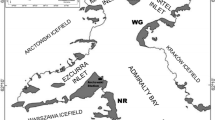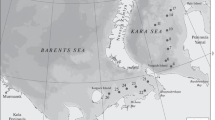Abstract
A site in the western part of Long Island Sound was monitored from January 2000 to May 2002. The littoral was divided into five different zones from the supra-littoral fringe (A) to the infra-littoral fringe (E). The midshore was dominated by Fucus vesiculosus L. and the sublittoral fringe by Chondrus crispus Stackh. There was a significant change in community structure over the years and the predominant change occurred between 2001 and 2002. The alternation in community structure was caused by an increase in abundance of species like Porphyra suborbiculata Kjellm., Porphyra leucosticta Type A and C (Neefus et al. 2000), Ceramium virgatum Roth, and Codium fragile subsp. tomentosoides (van Goor)Silva and a decrease in abundance in Fucus vesiculosus, Blidingia minima (Nägeli ex Kütz.) Kylin and Ulva lactuca L. The changes in community structure coincided with the change in environmental conditions. Air temperature as well as surface seawater temperature (depth <2 m) were the most important factors of those analyzed. Temperature seems to be the bottom-up force regulating the community structure.







Similar content being viewed by others
References
Bertness MD, Leonard GH (1976) The role of positive interactions in communities: Lessons from intertidal habitats. Ecology 78:1976–1989
Bertness MD, Leonard GH, Levine JM, Bruno JF (1999a) Climate-driven interactions among rocky intertidal organisms caught between a rock and a hot place. Oecologia 120:446–450
Bertness MD, Leonard GH, Levine JM, Schmidt PR, Ingraham AO (1999b) Testing the relative contribution of positive and negative interactions in rocky intertidal communities. Ecology 80:2711–2726
Brodie J, Hayes PK, Barker GL, Irvine LM, Bartsch I (1998) A reappraisal of Porphyra and Bangia (Bangiophyceae, Rhodophyta) in the Northeast Atlantic based on the rbcL-rbcS intergenic spacer. J Phycol 34:1069–1074
Broom JE, Nelson WA, Yarish C, Jones WA, Rosas RA, Rosas LEA (2002) A reassessment of the taxonomic status of Porphyra suborbiculata, Porphyra carolinensis and Porphyra lilliputiana (Bangiales, Rhodophyta) based on molecular and morphological data. Eur J Phycol 37:227–235
Carmona R, Kraemer GP, Zertuche JA, Chanes L, Chopin T, Neefus C, Yarish C (2001) Exploring Porphyra species for use as nitrogen scrubbers in integrated aquaculture. J Phycol 37:10–10
Chopin T, Buschmann AH, Halling C, Troell M, Kautsky N, Neori A, Kraemer GP, Zertuche-Gonzalez JA, Yarish C, Neefus C (2001a) Integrating seaweeds into marine aquaculture systems: A key toward sustainability. J Phycol 37:975–986
Chopin T, Yarish C, Neefus C, Kraemer G, Zertuche-Gonzalez J, Belyea E, Carmona R (2001b) Aquaculture from a different angle: the seaweed perspective, and the rationale for promoting integrated aquaculture. Cape Cod Press, Falmouth USA
Chopin T, Yarish C, Neefus C, Kraemer GP, Belyea E, Carmona R, Saunders GW, Bates C, Page F, Dowd M (2001c) Underutilized tools: seaweeds as bioremediation and diversification tools and bioindicators for integrated aquaculture and coastal management. J Phycol 37:12–12
Clarke KR (1993) Non-parametric multivariate analysis of changes in community structure. Aust J Ecol 18:117–143
Clarke KR, Ainsworth M (1993) A method of linking multivariate community structure to environmental variables. Mar Ecol Prog Ser 92:205–219
Dudgeon SR, Steneck RS, Davison IR, Vadas RL (1999) Coexistence of similar species in a space-limited intertidal zone. Ecol Monogr 69:331–352
Gray JS, Clarke KR, Warwick RM, Hobbs G (1990) Detection of initial effects of pollution on marine benthos: An example from the Ekofisk and Eldfisk oilfields, North Sea. Mar Ecol Prog Ser 66:285–299
Hiscock K, Mitchell R (1980) The discription and classification of sublittoral epibenthic ecosystems. In Farnham WF, Irvine DEG, Price JH (eds) The shore environment, Vol. 2. Ecosystems. Academic Press, London, 323–370
Hunter MD, Price PW (1992) Playing chutes and ladders: heterogeneity and the relative roles of bottom-up and top-down forces in natural communities. Ecology 73:724–732
Keser M, Swenarton JT, Vozarik JM, Foertch JF (2003) Decline in eelgrass (Zostera marina L.) in Long Island Sound near Millstone Point, Connecticut (USA) unrelated to thermal input. J Sea Res 49:11–26
Keser M, Swenarton JT, Foertch JF (2005) Effects of thermal input and climate change on growth of Ascophyllum nodosum (Fucales, Phaeophycea) in eastern Long Island Sound (USA). J Sea Res 54:211–220
Lasiak T (2003) Influence of taxonomic resolution, biological attributes and data transformations on multivariate comparisons of rocky macrofaunal assemblages. Mar Ecol Prog Ser 250:29–34
Leonard GH (2000) Latitudinal variation in species interactions: A test in the New England rocky intertidal zone. Ecology 81:1015–1030
Leonard GH, Levine JM, Schmidt PR, Bertness MD (1998) Flow-driven variation in intertidal community structure in a Maine estuary. Ecology 79:1395–1411
Levine IA (1998) Commercial cultivation of Porphyra (nori) in the United States. World Aquac 29:37–47
Lindstrom SC, Cole KM (1993) The systematics of Porphyra: Character evolution in closely related species. Hydrobiologia 260–261:151–157
Lubchenco J (1980) Algal zonation in the New England rocky intertidal community: an experimental analysis. Ecology 61:333–344
Lubchenco J (1983) Littorina and Fucus: Effects of herbivores, substratum heterogeneity, and plant escapes during succession. Ecology 64:1116–1123
Lubchenco J, Menge BA (1978) Community development and persistence in a low rocky intertidal zone. Ecol Monogr:67–94
Mathieson AC, Penniman CA (1986) Species composition and seasonality of New England seaweeds along an open coastal-estuarine gradient. Bot Mar 29:161–176
Mathieson AC, Shipman JW, O’Shea JR, Hasevlat RC (1976) Seasonal growth and reproduction of estuarine fucoid algae in New England. J Exp Mar Biol Ecol 25:273–284
Mathieson AC, Hehre EJ, Reynolds NB (1981a) Investigations of New England marine algae I: A floristic and descriptive ecological study of the marine algae at Jaffrey Point, New Hampshire, U.S.A. Bot Mar 24:521–532
Mathieson AC, Reynolds NB, Hehre EJ (1981b) Investigations of New England marine algae II: The species composition, distribution and zonation of seaweeds in the Great Bay Estuary System and the adjacent open coast of New Hampshire. Bot Mar 24:533–546
Menge BA (1976) Organization of the New England rocky intertidal community: Role of predation, competition and environmental heterogeneity. Ecol Monogr 46:355–393
Menge BA (1978a) Predation intensity in a rocky intertidal community. Relation between predator foraging activity and environment harshness. Oecologia 34:1–16
Menge BA (1978b) Predation intensity in a rocky intertidal community. Effect of an algal canopy, wave action and desiccation on predator feeding rates. Oecologia 34:17–35
Menge BA (1983) Components of predation intensity in the low zone of the New England rocky interdital region. Oecologia 58:141–155
Menge BA (1991) Generalizing from experiments: Is predation strong or weak in the New England rocky intertidal? Oecologia 88:1–8
Menge BA (2000) Top-down and bottom-up community regulation in marine rocky intertidal habitats. J Exp Mar Biol Ecol: 257–289
Menge BA, Daley BA, Lubchenco J, Sanford E, Dahlhoff E, Halpin PM, Hudson G, Burnaford JL (1999) Top-down and bottom-up regulation of New Zealand rocky intertidal communities. Ecol Monogr 69:297–330
Neefus CD, Mathieson AC, Yarish C, Klein A, West A, Teasdale B, Hehre EJ (2000) Five cryptic species of Porphyra from the Northwest Atlantic. J Phycol 36:suppl
Neefus CD, Mathieson AC, Klein AS, Teasdale B, Bray T, Yarish C (2002) Porphyra birdiae sp. nov. (Bangiales, Rhodophyta): A new species from the Northwest Atlantic. Algae 17:203–216
Nelson WA, Knight GA, Hawkes MW (1998) Porphyra lilliputiana sp. nov. (Bangiales, Rhodophyta): A diminutive New Zealand endemic with novel reproductive biology. Phycol Res 46:57–61
Nelson WA, Broom JE, Farr TJ (2000) Confusing convergent morphologies: Diversity and difficulties in New Zealand Erythropeltidales and Bangiales. J Phycol 36
Nelson WA, Broom JE, Farr TJ (2001) Four new species of Porphyra (Bangiales, Rhodophyta) from the New Zealand region described using traditional characters and 18S rDNA sequence data. Cryptogamie: Algol 22:263–284
Olsgard F, Somerfield PJ (2000) Surrogates in marine benthic investigations – which taxonomic unit to target? J Aquat Ecosyst Stress Recovery 7:25–42
Olsgard F, Somerfield PJ, Carr MR (1997) Relationships between taxonomic resolution and data transformations in analyses of a macrobenthic community along an established pollution gradient. Mar Ecol Prog Ser 149:1–3
Olsgard F, Somerfield PJ, Carr MR (1998) Relationships between taxonomic resolution, macrobenthic community patterns and disturbance. Mar Ecol 172:25–36
Oohusa T (1992) Recent trends in nori products and markets in Asia. J Appl Phycol 5:155–159
Pearson ES, Hartley HO (1966) Biometrika Tables for Statisticians. Cambridge
Petraitis PS (1983) Grazing patterns of the periwinkle and their effect on sessile intertidal organisms. Ecology 64:522–533
Petraitis PS (1987) Factors organizing rocky intertidal communities of New England: Herbivory and predation in sheltered bays. J Exp Mar Biol Ecol 109:117–136
Sears JR (1998) NEAS Keys to the Benthic Marine Algae of the Northeastern Coast of North America from Long Island Sound to the Strait of Belle Isle. Available from the UMass Dartmouth Campus Book Store, Dartmouth, MA
Terlizzi A, Fraschetti S, Guidetti P, Boero F (2002) The effects of sewage discharge on shallow hard substrate sessile assemblages. Mar Pollut Bull 44:544–550
Terlizzi A, Bevilacqua S, Fraschetti S, Boero F (2003) Taxonomic sufficiency and the increasing insufficiency of taxonomic expertise. Mar Pollut Bull 46:556–561
Tseng CK, Fei XG (1987) Economic aspects of seaweed cultivation: Macroalgal commercialization in the Orient. Hydrobiol 151–152:167–172
Warwick RM (1988) Effects on community structure of a pollutant gradient – summary. Mar Ecol Prog Ser 46:207–211
Yarish C, Frankenstein G, Sperr AE, Fei XC, Mathieson AC, Levine I (1997) Domestication of Porphyra (=nori) for north-east America. J Shellf Res 16:296–297
Yarish C, Wilkes R, Chopin T, Fei XG, Mathieson AC, Klein AS, Neefus CD, Mitman GG, Levine I (1998) Domestication of indigenous Porphyra (nori) species for commercial cultivation in Northeast America. World Aquac 29:26–30
Yarish C, Chopin T, Wilkes R, Mathieson AC, Fei XG, Lu S, Parsons GJ (1999) Domestication of nori for northeast America: The Asian experience. Bull Aquac Assoc Can 99–1:11–17
Author information
Authors and Affiliations
Corresponding author
Rights and permissions
About this article
Cite this article
Pedersen, A., Kraemer, G. & Yarish, C. Seaweed of the littoral zone at Cove Island in Long Island Sound: annual variation and impact of environmental factors. J Appl Phycol 20, 869–882 (2008). https://doi.org/10.1007/s10811-008-9316-6
Received:
Revised:
Accepted:
Published:
Issue Date:
DOI: https://doi.org/10.1007/s10811-008-9316-6




